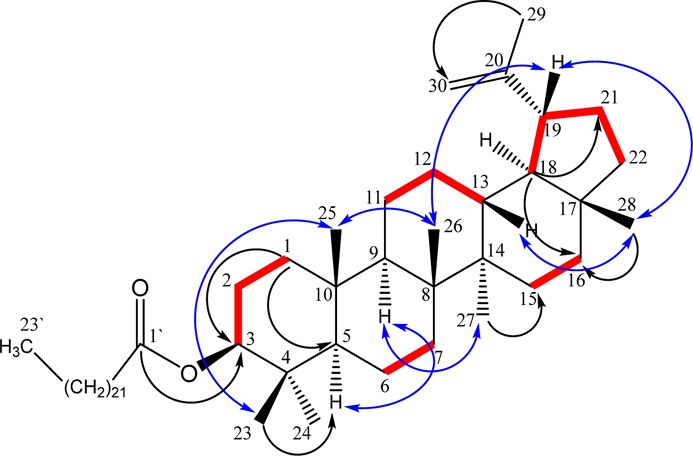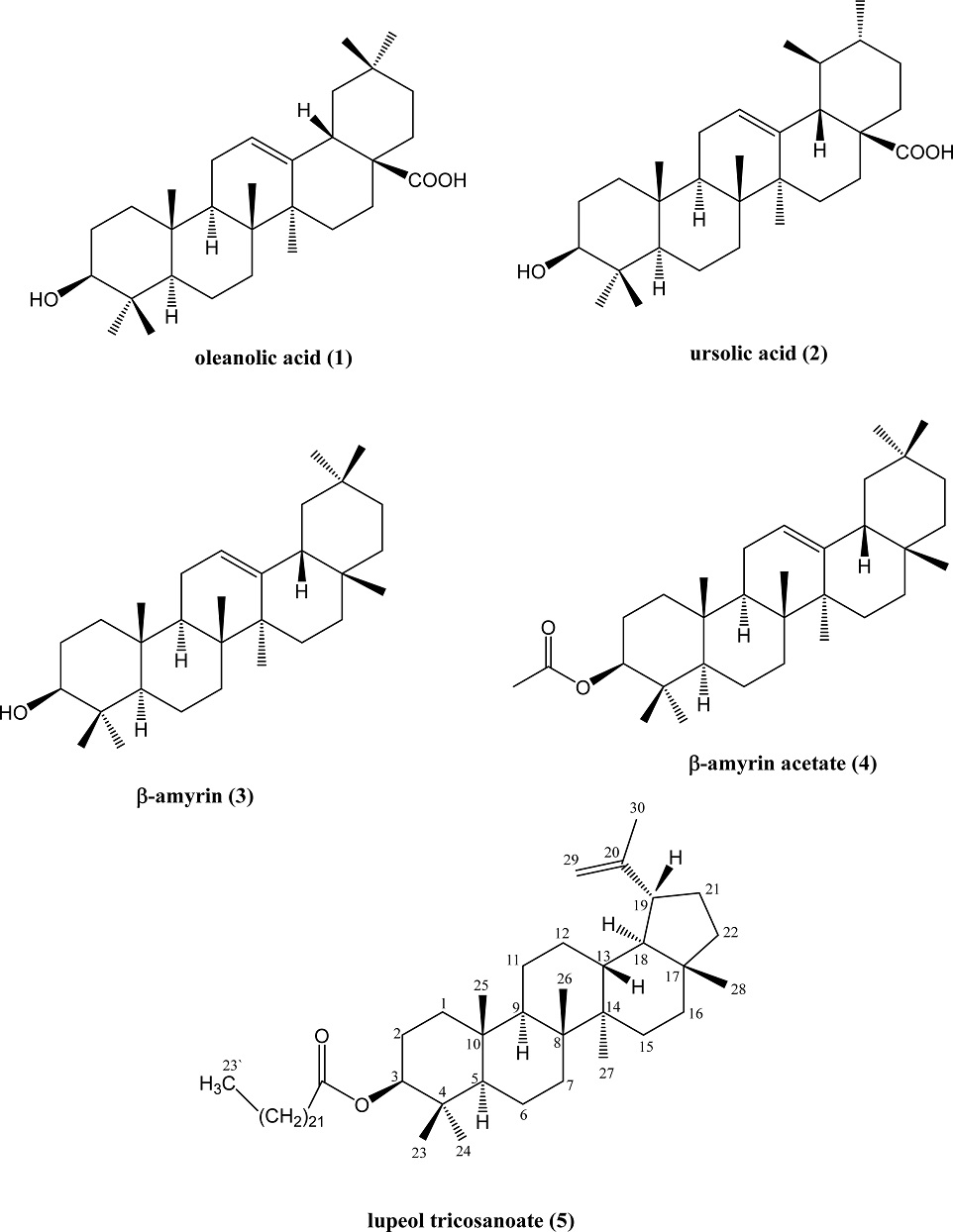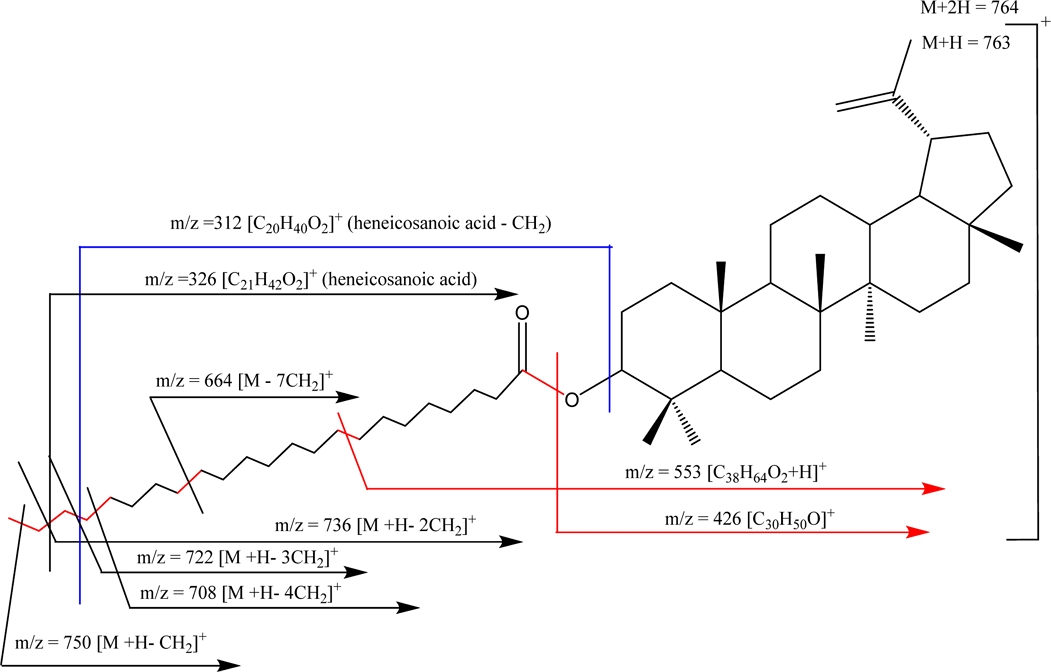
A Cytotoxic Lupeol Fatty Acid Ester and Other Pentacyclic Triterpenes from Salvadora persica Seeds
Abstract
The phytochemical investigation of the ethyl acetate fraction of the methanol seed extract of Salvadora persica resulted in the isolation and identification of five pentacyclic triterpenes (1-5), oleanolic acid (1), ursolic acid (2), β-amyrin (3), β-amyrin acetate (4) and lupeol tricosanoate (5). The structures of these compounds were established by the analysis of their NMR spectroscopic and mass spectrometric data. In the bioactivity assay, compound 5 showed moderate cytotoxic activities against breast cancer cell lines (MCF-7), colon cancer cell lines (HT-29) and hepatocellular carcinoma cell lines (HepG2) with IC50 values of 9.4, 6.85 and 12.74 μg/mL. respectively. In all previous studies, lupeol tricosanoate (5) has been isolated as a mixture of triterpenoid long-chain fatty acid esters and this is the first report of its isolation and characterization as a pure molecule. Moreover, the occurrence of fatty acid ester of triterpene in this plant is of taxonomic importance.
Keywords:
Salvadora persica, Triterpenes, Lupeol tricosanoate, Cytotoxicity, NMRIntroduction
Salvadora persica L. (Salvadoraceae), locally called miswak, has been scientifically proven to be very useful in the prevention of tooth decay.1-3 Extracts of S. persica exhibit various biological activities including antibacterial and antifungal effects.4-6 The previous phytochemical investigations revealed that S. persica contains alkaloids, glycosides, flavonoids, carbohydrates, tannins, saponins, steroids and terpenoids.7,8
Pentacyclic triterpene long-chain fatty acid esters are widely distributed in the plant kingdom and have been under investigation for many decades.9 Long-chain fatty acid esters of lupeol were shown to have strong anti-malarial, antinociceptive and anti-inflammatory activities.10 However, in most of the previous studies the isolation and identification of these compounds as mixtures prevented their complete characterization and biological evaluation. Our previously published data8 led to the isolation and identification of several phytosteroids from the n-hexane extract of S. persica. In continuation of our studies on the phytochemical investigation of this plant species, we report herein the isolation and characterization of five pentacyclic triterpenes from the ethyl acetate extract (1-5), oleanolic acid (1), ursolic acid (2), β-amyrin (3), β-amyrin acetate (4) and lupeol tricosanoate (5) (Fig. 1). To the best of our knowledge, a significant number of studies reported the identification of compound 5 in plant species in different families as a mixture with other triterpene long-chain fatty acid esters and has never been isolated as a pure molecule in these previous reports.11-14 Moreover, the cytotoxic activity of these metabolites was assessed towards breast cancer cell lines (MCF-7), colon cancer cell lines (HT-29) and hepatocellular carcinoma cell lines (HepG2) using MTT colorimetric assay method.15
Experimental
General experimental procedures – Silica gel (230-400 mesh; Merck, Darmstadt, Germany) was used for column chromatography. Silica gel 60 F254 plates (Merck, Germany) were used for thin layer chromatography analysis. The chromatograms were visualized under UV light then sprayed with Dragendorff’s and vanillin reagents. Optical rotations were measured on a Jasco P-1020 polarimeter in CHCl3. Infra-Red spectra were recorded on a Bruker IFS instrument. ESIMS spectra were recorded on LC-MS TOF (Bruker, Germany). NMR spectra were obtained in CDCl3 on Bruker 400 spectrometers using TMS as an internal standard.
Plant materials – The seeds of S. persica were collected during the flowering period from Jabal Fayfa in Jazan region, Saudi Arabia on June 2021 and identified by Dr. Wael T. Kassim, Department of Botany, Jazan University, Saudi Arabia. A voucher specimen (120-42068) has been deposited in Jazan University Herbarium (JAZUH).
Extraction and isolation – S. persica seeds (450 g) were extracted (4 × 1 L) with MeOH at room temperature. The MeOH extract (125 g) was partitioned successively with hexane, CH2Cl2, EtOAc and n-BuOH. The ethyl acetate residue (18.4 g) was separated by silica gel column chromatography using hexane/CH2Cl2 (5:1) as eluent. On the basis of their TLC characteristic, the fractions were combined to afford eight sub-fractions (F1-F8). The major fraction F3 (430 mg) was subjected to silica gel column chromatography and eluted with CH2Cl2/MeOH (20:1) to afford 1 (40 mg) and 2 (65 mg). Fraction F3 (280 mg) was separated by silica gel column chromatography and elution with CH2Cl2/MeOH (8:1) to give 3 (48 mg) and 4 (72 mg). Purification of fraction F1 (350 mg) by silica gel column chromatography and elution with hexane/CH2Cl2 (8:1) gave 5 (82 mg).
Lupeol tricosanoate (5) – White amorphous powder: : +11.7 (c 0.1, CHCl3); IR (KBr) νmax cm-1: 2946, 2832, 1734, 1665, 1468, 845, 712; 1H, 13C NMR: see Table 1.; ESI-TOF-MS: m/z 764.5668 [M+2H]+ (calcd. m/z 764.7410 for C53H96O2).
Cytotoxicity assay – The cytotoxicity of compounds (1-5) was evaluated by using the previously described method,15 using MTT cell proliferation assay kits. The following three cancer cell lines have been studied: breast cancer cell lines (MCF-7), colon cancer cell lines (HT-29) and hepatocellular carcinoma cell lines (HepG2). The cells were cultured in RPMI-1640 at 37oC with 5% CO2, supplemented with 10% FBS, penicillin, and streptomycin sulphate. They were grown in a 96-well flat-bottom plate (200 µL, 1 × 105 cells/well, in triplicated) and incubated for 24 h. After that, DMSO solutions of the residues at concentrations of 30 and 100 µg/mL were added to the wells. Then the treated cells were incubated for 48 h at 37oC, followed by the MTT assay. The absorbance (OD; λ = 570 nm) was recorded and the cell survival was determined using non-linear regression analysis. Camptothecin (Sigma-Aldrich, St. Louis, Missouri, USA) was used as a positive control.
Alkaline hydrolysis of 5 – Compound 5 (5.0 mg) was boiled with 2 mL 5 % KOH in 20 mL benzene for 24 h. The solution was evaporated to dryness and the residue, after addition of H2O, extracted with chloroform to remove the triterpene. The alkaline solution was acidified with HCI and extracted with ethyl acetate to remove the fatty acids. The solution was evaporated to dryness and esterified with diazomethane in benzene. The methyl tricosanoate ester was investigated by GC/MS (tR 31.3 min, m/z = 368).12
Result and Discussion
Structure characterization of compounds 1-4 was carried out by interpretation of their NMR spectral data and comparison with the data previously reported in the literature.10,11,13,16-19 Compound 5 was isolated as a white amorphous powder showing [α]D +11.7 (CHCl3). The ESI-TOF-MS in the positive ionization mode indicated a molecular ion peak [M+2H]+ at m/z 764.5668 which is consistent with the molecular formula C53H96O2. The peak at m/z 426 [C30H50O]+ was due to the loss of a tricosanoic acid unit from the molecular ion. One characteristic mass fragment at m/z 750 is due to the loss of one methylene group [M+H-CH2]+. Meanwhile, the successive loss of methylene groups gave fragment ions at m/z, 736 [M+H-2CH2]+, 722 [M+H-3CH2]+, 708 [M+H-4CH2]+ and 664 [M-7CH2]+. The fragments at m/z 326 [C21H42O2]+ and 312 [C20H40O2]+ were due to the loss of one methylene and two methylene groups from tricosanoic acid residue, respectively (Fig. 2).
The complete 1H and 13C NMR assignments of 5 were achieved on the basis of extensive 1D and 2D NMR (1H and 13C, DEPT, COSY, ROESY, HSQC, and HMBC) as well as mass spectral data. The 1H, 13C and DEPT NMR spectra of 5 exhibiting features characteristic of lupeol-type triterpene [δH 4.67 (J = 5.7 Hz), H-29a; δH 4.56 (J = 5.7 Hz), H-29b; δH 4.21 (br), H-3; δC 80.72, C-3; δC 150.96, C-20; and δC 109.33, C-29] and signals due to seven tertiary methyl groups.11,20 In addition to these characteristic features of lupeol, a terminal overlapped triplet for methyl signal at δH 0.78 and strong methylene proton signals around δH 1.43 indicative of the presence of a long chain fatty acid unit. These observations were supported by the appearance of 13C signals due to an ester carbonyl group at δC 173.76, a long-chain of methylene groups at δC 29.30-29.68 and a terminal methyl group at δC 14.1.
The 13C and DEPT NMR spectra of 5 revealed the presence of 53 resonances which were assigned with the help of an HSQC experiment and ascribed to 8 methyls, 32 methylenes, 6 methines, and 7 quaternary carbons (Table 1). The long chain fatty acid comprised a C23 moiety according to ESIMS measurements of 5 which displayed a small but important signal at m/z 338 [C23H46O]+.

In-vitro cytotoxic activity of phytochemicals (1-5) on the tested human cell lines breast cancer cell lines (MCF-7), colon cancer cell lines (HT-29) and hepatocellular carcinoma cell lines (HepG2)
The significant downfield chemical shifts of H-3 and C-3 indicated the linkage of the long-chain fatty acid unit at C-3 of lupeol. This linkage was confirmed by the observed HMBC correlation (Fig. 3) from the oxygenated methine proton around δH 4.21 to the ester carbonyl carbon at δC 173.76. The presence of tricosanoic acid moiety was confirmed by the alkaline hydrolysis of 5 which yielded lupeol and a fatty acid residue. The methyl ester furnished by methylation of the corresponding acid with diazomethane12 were characterized by GC/MS analysis as methyl tricosanoate (tR 31.3 min, m/z = 368).

Selected HMBC (Black arrows), COSY (Red bold lines) and ROESY (Blue arrows) correlations for compound 5.
The relative configuration of 5 was inferred from the ROESY experiment (Fig. 3). The observed correlations of H-19/Me-28, H-13/Me-28, H-19/M2-26, Me-25/Me-26 and Me-23/Me-25 indicated the orientation of H-19, Me-28, H-13, Me-26, Me-25 and Me-23, respectively.
The 1H and 13C resonance assignments for 5 are in perfect agreement with that reported for lupeol tricosanoate isolated in a mixture of long-chain fatty acid esters of triterpenes.11 Thus, the structure of 5 was determined unambiguously as lup-20(29)-en-3-tricosanoate. This is the first report for the occurrence of lupeol fatty acid ester in S. persica.
Compounds (1-5) were evaluated for their in-vitro cytotoxic activity against breast cancer cell lines (MCF-7), colon cancer cell lines (HT-29) and hepatocellular carcinoma cell lines (HepG2) by MTT colorimetric assay method.15 Compounds 1 and 2 showed the most potent cytotoxic profile towards HT-29 with IC50 2.11 μg/mL and 4.48 μg/mL. respectively. In addition, compounds (1-3) showed cytotoxic effects with IC₅₀ values ranging from 10.99 to 47.52 μg/mL against MCF-7, and HepG2 while compound 5 displayed moderate cytotoxic activity toward MCF-7, HT-29 and HepG2 cell lines with IC50 values of 9.4, 6.85 and 12.74 μg/mL, respectively. On the other hand, compound 4 exhibited weak cytotoxic activity (>100 μg/mL) towards MCF-7 and HT-29 and inactivity towards HepG2.
Conflict of interest
The authors declare that there is no conflict of interest.
References
-
Chaurasia, A.; Patil, R.; Nagar, A. J. Oral. Biol. Craniofac. Res. 2013, 3, 98-101.
[https://doi.org/10.1016/j.jobcr.2012.09.004]

-
Alili, N.; Türp, J. C.; Kulik, E. M.; Waltimo, T. Arch. Oral Biol. 2014, 59, 441-447.
[https://doi.org/10.1016/j.archoralbio.2014.02.001]

- Almas, A. K.; Almas, K. Odontostomatol Trop. 2014, 37, 27-39.
- Al-sieni, A. I. Afr. J. Tradit. Complement Altern. Med. 2013, 11, 23-27.
-
Amir Alireza, R. G.; Afsaneh, R.; Hosein, M. S. S.; Siamak, Y.; Afshin, K.; Zeinab, K.; Mahvash, M. J.; Reza, R. A. J. Oral Biol. Craniofac. Res. 2014, 4, 19-23.
[https://doi.org/10.1016/j.jobcr.2014.01.001]

-
Noumi, E.; Snoussi, M.; Hajlaoui, H.; Valentin, E.; Bakhrouf, A. Eur. J. Clin. Microbiol. Infect. Dis. 2010, 29, 81-88.
[https://doi.org/10.1007/s10096-009-0824-3]

- Khan, W.; Mujum, A.; Shaikh, T.; Katekar, S. M.; Tambe, R.; Rub, R. A. Res. J. Pharmacogn. Phytochem. 2010, 2, 319-323.
-
El-Desouky, S. K.; Hawas, U. W.; Khemira, H.; Kim, Y. K. Revista Brasileira de Farmacognosia. 2018, 28, 564-567.
[https://doi.org/10.1016/j.bjp.2018.05.013]

- Ahmad, V. U.; Rahman, A. U. Pentacyclic Triterpenoids (Handbook of Natural Products Data); Elsevier Science: U. S. A., 1994, p 1556.
- Rasoanaivo, L. H.; Wadouachi, A.; Andriamampianina, T. T.; Andriamalala, S. G.; Razafindrakoto, E. J. B.; Raharisololalao, A.; Randimbivololona, F. J. Pharmacogn. Phytochem. 2014, 3, 68-72.
-
Tomosaka, H.; Koshino, H.; Tajika, T.; Omata, S. Biosci. Biotechnol. Biochem. 2001, 65, 1198-1201.
[https://doi.org/10.1271/bbb.65.1198]

-
Schmidt, J.; Lien, N. T.; Khoi, N. H.; Adam, G. Phytochemistry 1983, 22, 1032-1033.
[https://doi.org/10.1016/0031-9422(83)85051-1]

-
de Carvalho, M. G.; Velloso, C. R. X.; Braz-Filho, R.; Costa, W. F. J. Braz. Chem. Soc. 2001, 12, 556-559.
[https://doi.org/10.1590/S0103-50532001000400020]

-
Sobrinho, D. C.; Hauptli, M. B.; Appolinário, E. V.; Kollenz, C. L. M.; de Carvalho, M. G.; Braz-Filho, R. J. Braz. Chem. Soc. 1991, 2, 15-20.
[https://doi.org/10.5935/0103-5053.19910004]

-
Mosmann, T. J. Immunol. Methods. 1983, 65, 55-63.
[https://doi.org/10.1016/0022-1759(83)90303-4]

-
Ben nejma, A.; Besbes, M.; Guerineau, V.; Touboul, D.; Ben jannet, H.; Hamza, M. A. Arabian Journal of Chemistry 2017, 10, S2767-S2772.
[https://doi.org/10.1016/j.arabjc.2013.10.026]

-
Seebacher, W.; Simic, N.; Weis, R.; Saf, R.; Kunert, O. Magn. Reson. Chem. 2003, 41, 636-638.
[https://doi.org/10.1002/mrc.1214]

-
Jain, P. S.; Bari, S. B. Asian J. Plant Sci. 2010, 9, 163-167.
[https://doi.org/10.3923/ajps.2010.163.167]

-
Feleke, S.; Brehane, A. Bull. Chem. Soc. Ethiop. 2005, 19, 307-310.
[https://doi.org/10.4314/bcse.v19i2.21137]

-
Furukawa, S.; Takagi, N.; Ikeda, T.; Ono, M.; Nafady, A. M.; Nohara, T.; Sugimoto, H.; Doi, S.; Yamada, H. Chem. Pharm. Bull. 2002, 50, 439-440.
[https://doi.org/10.1248/cpb.50.439]


